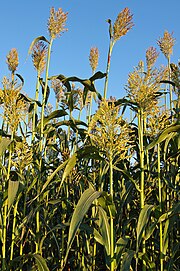In China, sorghum is known as gaoliang (高粱), and is fermented and distilled to produce one form of clear spirits known as baijiu 白酒 of which the most famous is Moutai (or Maotai). Sorghum was ground and the flour was the main alternative to wheat in northern China for a long time.
In India, where it is commonly called jwaarie, jowar, jola, or jondhalaa, sorghum is one of the staple sources of nutrition. An Indian bread called Bhakri, jowar roti or jolada rotti, is prepared from this grain. In some countries, sweet sorghum stalks are used for producing biofuel by squeezing the juice and then fermenting it into ethanol.[12] Texas A&M University in the United States is currently running trials to find the best varieties for ethanol production from sorghum leaves and stalks in the USA.[13]
In Korea, it is cooked with rice, or its flour is used to make cake called susu bukkumi.
In Australia, South America, and the United States, sorghum grain is used primarily for livestock feed and in a growing number of ethanol plants.[14]
In Central America, tortillas are sometimes made using sorghum. Although corn is the preferred grain for making tortillas, sorghum is widely used and is well accepted in Honduras. White sorghum is the preferred sorghum for making tortillas.[15]
In several countries in Africa, including Zimbabwe, Burundi, Mali, Burkina Faso, Ghana and Nigeria, sorghum of both the red and white varieties is used to make traditional opaque beer. Red sorghum imparts a pinkish-brown colour to the beer.[15]
Sorghum is one of a number of grains used as wheat substitutes in gluten-free recipes and products.
https://en.wikipedia.org/wiki/Sorghum_bicolor


Sorghum is cultivated in many parts of the world today. In the past 50 years, the area planted with sorghum worldwide had increased 66%.[7]In many parts of Asia and Africa, its grain is used to make flat breads that form the staple food of many cultures.[9][10] The grains can also be popped in a similar fashion to popcorn.
| Nutritional value per 100 g (3.5 oz) | |
|---|---|
| Energy | 1,418 kJ (339 kcal) |
74.63 g
| |
| Dietary fiber | 6.3 g |
3.30 g
| |
11.30 g
| |
| |
| Percentages are roughly approximated using US recommendations for adults. | |
The species can be used as a source for making ethanol fuel, and in some environments may be better than maize or sugarcane, as it can grow under harsher conditions.[5] It typically has protein levels of around 9%, enabling dependent human populations to subsist on it in times of famine, in contrast to regions where maize has become the staple crop. It is also used for making a traditional corn broom.[11]
The reclaimed stalks of the sorghum plant are used to make a decorative millwork material marketed as Kirei board.
Sweet sorghum syrup is known as molasses in some parts of the U.S., although it is not true molasses.
No comments:
Post a Comment